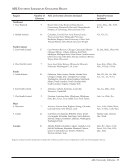Salary Survey Trends 2011–2012 · 11 ClimateQUAL® is an assessment initiative that focuses on some of the same issues. It is the Statistics and Assessment program’s tool that assesses organizational climate and diversity in libraries. ClimateQUAL® helps libraries plumb the dimensions of climate and organizational culture important for a healthy organization in a library setting. The ClimateQUAL® survey addresses climate issues such as diversity, teamwork, learning, and fairness, as well as current managerial practices, and staff attitudes and beliefs. Libraries use their ClimateQUAL® data to improve their organizational climate and diversity culture for delivering superior services to the communities they serve. More information about ClimateQUAL® can be found at http://www. climatequal.org. Gender data Many readers of previous surveys have inquired about evidence of gender-based salary differentials in ARL libraries. Additionally, data on salary comparisons for directors also are frequently requested. Since 2008–2009, the average salary for female directors was slightly higher than that of their male counterparts. However, for the second consecutive year the trend was reversed, with male directors earning more than female directors (see Table 17) furthermore, the number of women in the top administrative library position decreased to 65 out of 112 total director positions reported in 2011–2012 (see Table 17). In keeping with previous years, the 2011–2012 data show that salaries for women in US ARL university libraries have not yet met parity with that of men (see Table 17). In 2011–2012 the overall salary for women was only 96.22% of that of men for the 115 ARL university libraries (compared to 96.05% in 2010–2011). This suggests a slow, long-term trend towards closure of the gender gap in ARL libraries — in 1980–1981, women in ARL libraries made roughly 87% that of men. Table 17 displays 27 job categories females earn more than their male counterparts in just 14 of the 27 categories listed. Table 18 provides average years of professional experience for many of the same staffing categories for which salary data are shown in Table 17, revealing that experience differentials may explain some differences within specific job categories. Women have more experience in all but two of the six job categories in which they average higher pay. However, there are four other categories in which women, on average, have more experience and less pay: Associate Director, Assistant Director, Functional Specialist, and Department Head- Other. Table 19 further reveals that the average salary for men is consistently higher than the average salary for women in all ten experience cohorts. Among minority librarians, the average salary for minority men is higher than that for minority women in nine of the ten experience cohorts (see Table 30). There is a sense that the gender gap persists in academe in areas beyond the library and that a renewed commitment to resolve the problem is needed.3 A variety of reasons have been offered as to why these trends persist, most notably the perception that work is peripheral in a woman’s life and, consequently, female- dominated professions are undervalued. Librarianship is predominantly and persistently a woman’s profession. 3 There are many instances citing the continuation of gender inequity in academia. See, for example: Mary Ann Mason, “Still Earning Less,” Chronicle of Higher Education 13 January 2010 http://chronicle.com/article/Still-Earning-Less/63482/ Katherine Mangan, “Women in Academic Medicine: Equal to Men, Except in Pay,” Chronicle of Higher Education 31 March 2010 http://chronicle.com/article/Women- in-Academic-Medicine-/64892/ Paula Wasley, “Gender Gap in Pay Widens Over Time,” Chronicle of Higher Education 4 May 2007 http:// chronicle.com/article/Gender-Gap-in-Pay-Widens-Over/9208/ Denise K. Manger’s articles in the Chronicle of Higher Education, “Faculty Salaries Increased 3.7% in 1999–2000” (14 April 2000: A20) and “Faculty Salaries are Up 3.6%, Double the Rate of Inflation” (23 April 1999: A16) D. W. Miller, “Salary Gap Between Male and Female Professors Grows Over the Years, Study Suggests,” Chronicle of Higher Education, Today’s News, 27 April 2000 and Yolanda Moses, “Salaries in Academe: The Gender Gap Persists,” Chronicle of Higher Education 12 December 1997: A60.




























































































































